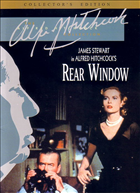
Rear Window
Year:1954
Director: Alfred Hitchcock
Actors: James Stewart, Grace Kelly
For lovers of mystery- movies, this 1954 Alfred Hitchcock classic is a must-see. Fifty years on, this film might evoke mixed reactions. By today’s standards, the suspense build-up is far too gradual; the accompanying music far too minimal and the climax far too meek. But what it shows is the director’s complete mastery over technicalities of cinematic medium and his brilliant use of cinematic idiom.
The story literally revolves around an adventurous freelance photographer L.B.Jeffries -‘Jeff’ (James Stewart). Jeff has broken his leg while covering an automobile race and with one leg in a plaster cast, he now has practically nothing to do but to remain confined to a wheel-chair in his small apartment. His elderly chatterbox caretaker Stella and his high society girl-friend Lisa (Grace Kelly) are the only ones visiting him and all they do is to pester him to get married. Unwilling to commit himself for a marriage with his girl-friend, he only has wry, cynical comments in response.
Lonely and bored, Jeff keeps himself amused by taking a rear window view into the lives of other apartment dwellers. It’s an interesting cross-section of humanity with a Miss ‘Lonelyheart’ desperate to find a companion, a constantly dancing and dating Miss Torso’, a musician trying to find bearing of his notes, a small-time sculptor lady in an unhappy marriage, a newly married couple oblivious to all, an odd couple sleeping in their gallery and another couple who keeps pampering a puppy.
Then there is a salesman Lars Thorwald (Raymond Burr) who makes three inexplicable middle-of-the-night trips out of his flat with a suitcase to arouse Jeff’s curiosity and to complicate matters, the salesman’s disabled wife is nowhere to be seen. Suspecting murder, Jeff’s telescopic lens starts zooming in on the activities of the salesman and through that lens-view we get sucked up into a mystery. Is it really a murder? Or is Jeff’s obsessed mind just playing tricks?
The hero is not heroic here. He is almost an obsessed ‘Peeping Tom’, less interested in his own affairs of heart but more interested in finding out about somebody else’s life. The closest he comes to action, is to flash his camera bulbs- otherwise he is just a mute spectator, seeing everything from sidelines but unable to do anything about it. This particular Hitchcock’s take is a swipe at voyeuristic attitude of man-kind. Through that flawed keyhole vision of a camera lens, he makes the mystery unravel itself. It is a masterpiece.
Do You Know?
-
The movie was entirely shot on the largest ever set constructed by Paramount studio till that time.
-
The set was illuminated by 1000 arc lights.
-
Such was the heat generated by these lights that once even the soundstage sprinkler system got activated.
-
For years, this movie (along with 4 other Hitchcock movies) was unavailable as Hitchcock had bought back the rights for his daughter.


